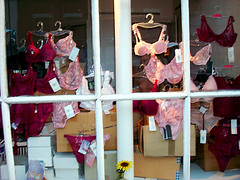SEE WHY I HATE PRIMARK
I made a crack last night to The Cardinal that I was aiming for Vintage Vogue but achieving something more like Help The Aged. I know I have A LOT of clothes but as smug as I am about my new Le Creuset casserole dish, I consciously didn't buy one thing last year from TOPSHOP and H&M and I bought some stuff from Primark on the Kilburn High Road between 1995 and 1997: a pair of grey tracksuit pants that I still use for painting and a navy pair of tracksuit paints that I think my ex husband took. Everything I own is vintage or junk whatever you want to call it for wherever, or from independent boutiques and preferably made within the EU. I will confess to COS. And when it comes to say goodbye to something I send it to my Mum or sister or take it in to the girls at work and see who wants what. Which at the end of the day leaves me with pretty clear conscience - though I still yearn for the red silk jersey ISSA dress I gave away.
I noticed today my friend Jessica had a link to this article on her FB [we used to work at Hamnett together]:
Disposable fashion: for sale, hardly worn, two million tonnes of clothes
As discount fashion stores flourish, second-hand clothes sellers and charities are drowning in cheap, low-quality textiles
Clothing for recycling and reusing arrives in huge piles at LMB in Canning Town , East London
Hannah Fletcher
In his textile recycling factory on the industrial outskirts of East London, Lawrence Barry wades across a floor feet-deep in other people's discarded clothing. Above him, precarious fabric dunes lean against the walls and reach up to the corrugated iron roof. The air is heavy with mothballs and the sweet, cloying stench of stale sweat.
There was a time, 58-year-old Barry says, when the clothes coming into his warehouse reeked of love, instead. “People used to buy a good-quality suit and that was it. That was their suit,” he says. “The clothes that ended up here were worn to death, treasured, loved.” Now the 100 workers at LMB Textile Recycling spend their days sorting through the detritus of our addiction to throwaway fashion - cheap, synthetic, often unworn, rarely loved. And Barry and his employees have unwittingly found themselves at the cutting edge of British eco-policy.
Textiles have never been a great concern for keen-to-be-seen-to-be-green governments that get more brownie points from an easy tonne of glass or paper. But the textile problem has become too vast to ignore.
In February the Department for Environment, Food and Rural Affairs (Defra) will launch a “sustainable clothing roadmap” to try to reduce the environmental impact of our clothes. In preparation, it has commissioned a series of studies in which the true extent of our shopping habit is revealed in stark detail.
In the past five years, with the rise of “value retailers” such as Primark, H&M and TK Maxx, and supermarket fashion ranges, the price of clothing in the UK has plummeted by up to 25 per cent. At the same time, the amount of clothes we buy has increased by almost 40 per cent to more than two million tonnes a year.
Instead of two annual seasons for clothes - winter and summer - we are now offered, and can afford, new apparel every few weeks. We buy fresh holiday wardrobes, which we wear for a fortnight. Our style icons are celebrities who are never seen in the same outfit twice. And as our high street stores reel from the credit crunch, still we are cashing in - packing out the shops, desperate for discounted clothes.
As a result, textiles have become the fastest-growing waste product in the UK. About 74 per cent of those two million tonnes of clothes we buy each year end up in landfills, rotting slowly (or not at all) in a mass of polyester, viscose and acrylic blends.
On a recent fact-finding trip to a waste-disposal site in Croydon, South London, MPs from the Environment, Food and Rural Affairs Committee learnt that the proportion of textile waste to other rubbish at council tips across the country has risen from 7 per cent to 30 per cent in five years.
Staff at the tip call the problem “the Primark effect”. Less than ten miles away, in Central London, the budget retailer's 70,000sqft flagship store flogs piles of ever cheaper, ever more disposable clothes. Even in a year ending with the most severe economic downturn in recent history, Primark recorded a 21 per cent sales increase in 2007/08.
Meanwhile, the poor quality of our cheap fashion fixes has caused the bottom to drop out of the recycled textile industry. The value of recycled material has fallen by 71 per cent over the past 15 years. Factor in collection and sorting costs, and many rag dealers and charities, forced to find outlets for donations that are too shabby to sell in their shops, find themselves paying out to recycle.
Furthermore, far less second-hand clothing is recyclable in the first place - a mere 3.5 per cent of that looming two million tonnes, or just under a third of the paltry 13 per cent of waste textiles that are recovered through charities, textile banks and rag dealers each year. (The remaining 13 per cent - clothing neither recovered nor sent to landfill - is incinerated.)
Lawrence Barry is no eco-warrior. He came into the business to make money. But back then, the trade was built on recycling. “When I started I was recycling 90 per cent of the clothes that came through,” he says. “Today it's down to 30 per cent.”
He speaks wistfully of the hard-wearing, workaday fabrics of yesteryear - linsey-woolsey and gabardine. They may have been coarse and drab but they were natural products and enjoyed second lives as industrial wiping cloths, insulation and stuffing.
Today, about two thirds of the fibres, yarns and fabrics coming into the UK are synthetic. They are blended into every conceivable combination - sometimes rendering them dangerously flammable in the process - and are nearly impossible to pick apart after use. Barry's recycling figure of 30 per cent is the norm across the second-hand clothing industry.
Most of the remaining 70 per cent is sent abroad, to Africa and Eastern Europe, where a booming industry has grown up around our unwanted exports. Critics have long condemned the practice for distorting fragile markets in developing countries. The donating public, too, has sometimes found it difficult to reconcile the friendly image of charity shops with the necessarily hard-nosed businesses behind them.
But the problem is of our own making. We are offloading more and more clothing to charities and textile banks, but more and more of it is unsellable in the UK. A negligible 1.7 per cent of our annual clothing purchases will end up being sold second-hand in Britain, and on average charity shop sales account for just 10 per cent of a charity's income.
“The rise of discount clothing and a culture of discarding have led to a clear reduction in the quality of many donated textiles,” says David Moir of the Association of Charity Shops. “This has put some pressure on donated stock for sale.”
“We have noticed more and more cheap clothes coming in but we can't sell them in the shops,” agrees Rob McNeill, a spokesman for Oxfam. “Who would buy a second-hand Primark T-shirt for a quid when there's a Primark down the road selling them new and probably cheaper? We can't compete.”
If you read the article this far, and what to read the rest, go here.
Anyway I have a little hang over to get over, which I will do by watching a few episodes of Criminal Minds. Then I will post some pics from last night and of my cooking adventures.
xx Lektrogirl
Labels: Fashion, Fucking Gross






















1 Comments:
This is good writing
Post a Comment
Links to this post:
Create a Link
<< Home